"Housekeeping"
Quality: "I think I get it now!"
That was the oft-heard refrain at Westgard Workshops 2002. For those of you who weren't able to attend the workshops, this has pictures of what we did, quotes from those who came, and some observations from Dr. Westgard on why these workshops are so important and so successful.
- What's the secret to teaching?
- What's the secret to understanding quality?
- What's the secret to a good workshop?
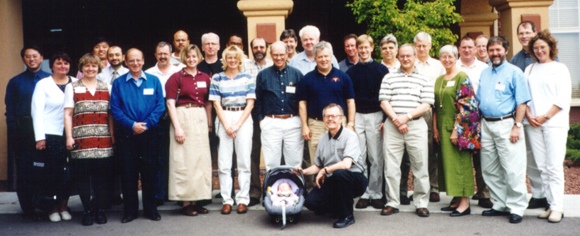
The Westgard Workshop/Six Sigma class of 2002, including Dr. Westgard's granddaughter, Linnea
During our recent workshops in Madison, more than once I heard the phrase - "I think I get it now!" As a teacher, it is always rewarding to see an idea take root in someone else's mind, particularly when you've been able to help that person gain a better understanding of the subject. Ideas live on long after the teacher quits talking! Students live on long after the teacher quits teaching!
"I think I get it now" is music to my ears! It reminds me of Willie Nelson's new CD "The Great Divide". Willie's getting older - maybe that's why this CD is so appealing. In the track "Recollection Phoenix," he sings about the wisdom that comes with age and experience, and he actually says "I think I get it now."

Westgard Workshops in action. In the back, Dr. Westgard roams the floor and takes questions.
What's the secret to teaching?
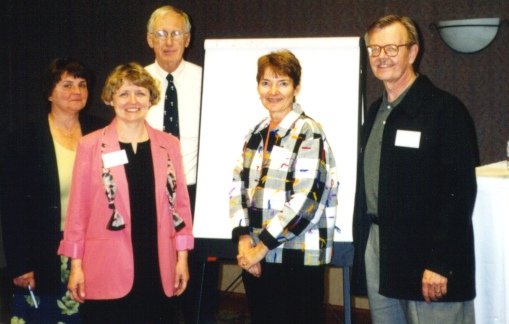 |
|
The Expert Panel from Day One: QC Issues and Answers |
Teaching is about revealing the secrets that make difficult subjects understandable. Often we teach on the basis of how we learned the subject ourselves. You might recall my method validation lesson titled The inner, hidden, deeper, secret meaning of method validation. Analytical quality management is all about errors - how to define the amount of error that is allowable, how to estimate the size of the errors occurring in your analytical methods, how to determine the size of the errors that need to be detected by QC, and how to assess whether your QC procedures can readily detect those errors.
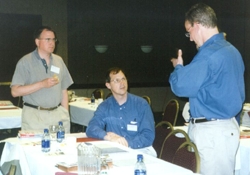 |
|
Participants discuess, digest, and digress during one of the breaks at Westgard Workshops 2002 |
I certainly try to teach the secrets that made the subject understandable to me. But, sometimes we forget many of the little secrets when a subject becomes very familiar. I know that's a problem and I often try telling the story in different ways and from different perspectives to be sure more of the secrets are revealed. That's one of the real advantages of the workshop setting where there is time to talk, answer questions, discuss issues, and challenge common assumptions and beliefs that affect our understanding and limit our learning of new ideas.
What's the secret to understanding quality?
To find out what secrets are particularly important for understanding quality, I asked several participants to identify the secret (or secrets) that created a "breakthrough" in their own learning and thinking about quality. Here's a sample of their responses.
Plain talk and time to think about it!
James Dohnal, PhD, DABCC, Director of Biochemistry and Outreach Services at Evanston Northwestern Healthcare, Evanston, IL: "OPSpecs charts and power functions with Six Sigma imposed over them suddenly became clear on the last day. You ask why it became clear at the seminar and not via your literature articles, books, or website? Well, I have tried many times to read your literature articles but have never managed to really understand them. This has caused me NOT to read your books or visit your website. Since the seminar, I have been reading your books. They are much different than the literature articles in terms of being much easier to understand. In fact, they read like the seminar flows. I guess it is just the difference between conversational English and journal English. Another thing that gives the seminar an advantage is that it provides protected time to really get into the subject."
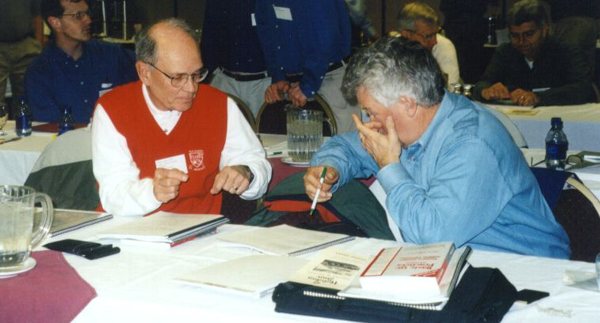
During another break, more discussion between Dr. Roger Calam and Dr. Craig Foreback. In the foreground, you see the various books that came with the registration: Basic QC Practices, 2nd Edition, Six Sigma Quality Design and Control, plus two workshop handouts, plus a messenger bag to carry it all
A challenge to current thinking about QC!
Alan McNabb, Supervisor, Molecular Services, BCCDC Laboratory Services, BC Center for Disease Control, Vancouver, British Columbia: "I would say without a doubt that this is one of the best workshops I have taken in the last 10 years. It is always interesting to encounter a class that makes you think and opens up new avenues in old subjects."
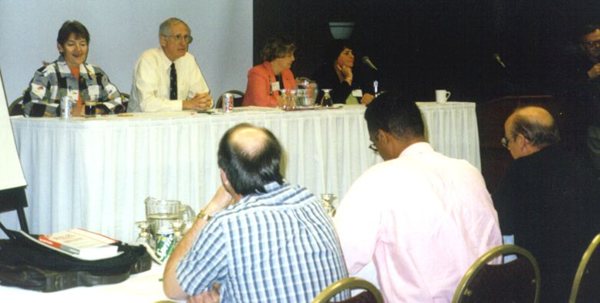
Day One: QC Issues and Answers - the Expert Panel takes questions. Not pictured here, Dr. Westgard, who was once again roaming in the audience.
A clear understanding of the medical usefulness of a laboratory test!
Curry Walker, QI Coordinator, USAMEDDAC, Wurtzburg, Germany: "The first day, I truly just sat and tried to absorb the concepts. The exercises we did on figuring the DPMs and sigma metrics were certainly helpful. The most important thing I came away with was the need to find out from our doctors how they use our laboratory information. A clear understanding of the medical usefulness of laboratory tests - that had been hazy to me before. My goal before the end of the year is to apply the OPSpecs charts for all our lab tests and assess the performance of our QC procedures. My second goal is to pass on my new knowledge of Six Sigma to the large European Department of Defense lab science group here in Germany."
A rational basis for selecting QC procedures!
Craig Foreback, PhD, Instructor, Clinical Laboratory Science Program, University of Wisconsin-Madison: "I have known for years that simply using a 2 SD rule for QC was inefficient and frustrating to technical staff. The introduction of "Westgard Rules" into the clinical laboratory was a fresh approach to the practice of QC and it gave us a new way of looking at our "out of control" situations. But which rules? Do you use all of them? What about the 10x rule? Then I took the Six Sigma workshop. I was trying to grasp the concept and after all the questions and discussions, I finally "got it"! Six Sigma is a rational concept that will allow us to select the right rules and number of control measurements. It became so simple. As an educator I want to see this idea included in the Quality Management portion of our training."
Simple calculations and easy to use graphical tools!
Virginia Burdine, MD, Midwest Pathology Associates, Tulsa, OK: "The concept of tailoring QC to each individual test using a handful of control designs made a lot of sense. Working through the sigma calculations was a useful exercise and helped me to move past my intimidation with statistical calculations. Finally, I really liked the power function graph with the sigma scale superimposed on it. I think that tool is easy to interpret and makes choosing your individualized control design conceptually easy."
Seeing the impact on my own QC!
Rozanna Templin, Northwestern Memorial Hospital, Chicago, IL: "My moment for getting a really good grasp of quality control came after entering our lab's actual data into the EZ Rules Program and seeing the results. That process helped me in two ways: (1) It gave me a structure for asking questions that were difficult to verbalize before, and; (2) It gave me information at a glance, via the OPSpecs charts, about our analyzers' performance, the directions needed to improve performance, and the appropriate assessments to assure their quality. I would definitely recommend spending the time inputting real numbers into EZ Rules. The perspective it provides is worth the effort."
A new standard of practice for laboratory quality management!
Roger Calam, PhD, DABCC, Associate Director Clinical Chemistry, St. John Hospital & Medical Center, Detroit, MI: "The workshop clarified and made meaningful for me the Six Sigma concept as applicable to quality management in the laboratory and the quality control of the analytical process. The material was presented with thought-provoking discussion which helped me realize, "of course"! The light bulb came on, if you will, as I immersed myself in the examples presented, worked the formulas, grasped the terminology, and understood the relationship between class QC rules, power function graphs, OPSpecs charts, critical error graphs, and the Sigma Metric calculations. A feeling of satisfaction occurred as I realized I had just experienced something very significant, meaningful, and importantly, practical - not out of grasp. The interface between Six Sigma and applied quality control could very well usher in a new standard of practice for not only controlling true lab testing process but also allowing for a quantitative understanding of the true quality capability of the test system. Knowing what Sigma we are at will help us define what Sigma we need to try to get to."
A framework for continuous quality improvement!
Theresa Darcy, MD, Medical Director of Clinical Laboratories, University of Wisconsin Hospitals and Clinics, Department of Pathology and Laboratory Medicine, Madison, WI: "As I listened to the presentations and discussion a framework for QC planning and Six Sigma Design began to take shape in my mind. The framework was elegant in its simplicity, transparent from any angle, and infinitely flexible in size. My QC frame could be applied to an individual laboratory test as well as to complex interdepartmental processes. The workshop opened my eyes to the value of QC planning in laboratory continuous quality improvement. I intend to use my framework as a tool to reduce error, decrease process variation, and control cost."
A perfect fit with the big picture!
Jim Ellis, Director Lab Consulting, Ortho Clinical Diagnostics, Raritan, NJ: "I did have a breakthrough moment when it hit me that your methodology...takes care of the analytical "box". I see a lot of synergies and have already promoted your course as a pre-requisite for getting a first look at Six Sigma in the area of lab services. It fits very well with then going on to getting a Black Belt with a concentration in lab services."
What's the secret to a good workshop?
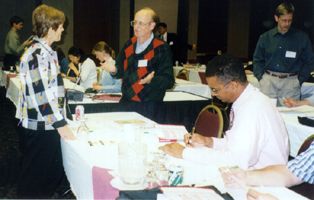 |
|
Dr. Sharon Ehrmeyer talks with Dr. Andreas Rothstein during one of the breaks. There was plenty of time for informal questions and answers. Participants were even taken out to dinner and a tour of Madison's sites. |
As you can see from the list of secrets, it's not the same idea that "clicks" with everyone. Different people have different backgrounds and experiences. Different ideas impact in different ways.
The secret of a workshop as a learning experience is that there are many chances to get the right idea to the right person. Some of those chances come about through preparation of materials and formal presentation of ideas. Many other chances come about through questions and answers, informal discussions, and interactions with other participants. If you don't get it right the first time, there are many opportunities to get it right before the workshop is over.
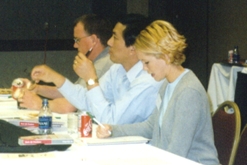 Perhaps the most important factor is that each individual has made a commitment to spend time and energy to improve their knowledge of a subject. That commitment is enhanced by the presence of others who have similar interests and broad experiences. A commitment to learning, an interest in the subject matter, and experience in the real world improve the learning opportunity for everyone.
Perhaps the most important factor is that each individual has made a commitment to spend time and energy to improve their knowledge of a subject. That commitment is enhanced by the presence of others who have similar interests and broad experiences. A commitment to learning, an interest in the subject matter, and experience in the real world improve the learning opportunity for everyone.
That's why I find workshops to be fun and rewarding! I can see that learning is taking place. I can sometimes help make it happen by telling the story in a different way and revealing the secret in a different light.
For inquiries about his schedule of public appearances and/or availability for private workshops send us an email.
James O. Westgard, PhD, is a professor of pathology and laboratory medicine at the University of Wisconsin Medical School, Madison. He also is president of Westgard QC, Inc., (Madison, Wis.) which provides tools, technology, and training for laboratory quality management.
